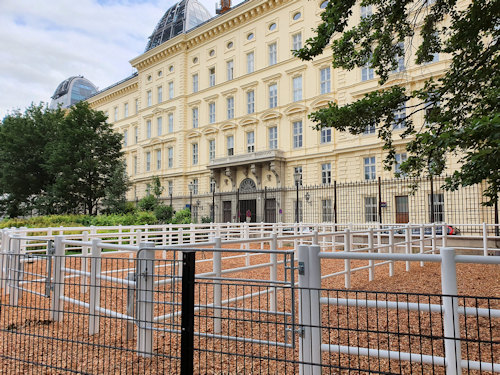
If you ever get a little weary from all the sightseeing, pop into the Burggarten park alongside the tourist hotspots for a bit of a rest. Then thank Napoleon for the opportunity.
- City centre park famous for its Mozart statue
- Borders the Hofburg and Albertina attractions
- Nice place to sit and relax while sightseeing
- You might spot a Lipizzaner stallion there, too
- Book a guided tour* of the Hofburg area
- See also:
- The Mozart monument
- The Butterfly House
Burggarten history

(View of the Burggarten across from the Hofburg)
When Napoleon’s troops withdrew from Vienna in 1809, clutching the Treaty of Schönbrunn and their souvenir fridge magnets, the mess they left behind demanded a redesign of the area around the Hofburg Imperial complex.
Part of this redesign was the creation of the Kaisergarten or Emperor’s garden, a private area for the ruling family to take off their shoes and enjoy a picnic (possibly).
The authorities extended the area in 1863, then reduced it again a few decades later to create space for the Neue Burg palace extension that now borders the northwest side of the park.

(Remarkably, a photo taken around 1863 by Franz Antoine (jun.) of the park’s old winter glasshouse; Wien Museum Inv.-Nr. 55802/18; excerpt reproduced with permission under the terms of the CC0 licence)
Following the demise of the monarchy and the change to a republic in 1919, the Kaisergarten passed to the state. At the time, many streets and similar were renamed to remove the Imperial connection. And so the Emperor’s Garden simply became the Burggarten.
Inside the Burggarten
This Burggarten – currently managed by the federal garden services (the Bundesgärten) – does not offer the floral beauty associated with the Volksgarten on the other side of Heldenplatz square.
The park does, however, provide nice views of its palatial surrounds: the rear of that Neue Burg extension as well as the Jugendstil imperial glasshouses that now feature, for example, a butterfly house and café-restaurant, with the Albertina palais and art museum just beyond.

(The monument to Mozart with the Neue Burg behind)
Consider it a place to enjoy some greenery in the middle of a city and a little respite from sightseeing crowds.
The location does have one particular ace up its sleeve. The famous Mozart monument moved to the Burggarten in 1953 to become one of Vienna’s most popular photo motifs
Another three statues complete the collection of manmade highlights within the park.
1. Hercules and the Nemean lion (created around the turn of the 19th century and incorporated into a small fountain feature in the Burggarten pond in 1948).

(Franz Stephan’s equestrian statue dates back to 1781, but moved here in 1819)
2. Franz Stephan (1708-1765), who was the husband of Empress Maria Theresa. His wife has a larger monument on the other side of the road.
3. Emperor Franz Joseph (1830-1916). He has a rather pensive look about him, almost as if he knew time was slowly running out for Habsburg rule.

(An emperor and dynasty nearing the end of their time)
If you’ve ever watched the period detective series, Vienna Blood, then you’ll recognise the Burggarten (and Franz Joseph) from both Season 1 and Season 2.
A monument to German writer, Goethe, stands just outside the southeast entrance to the park, too.
In mid-2021, a small part of the Burggarten converted to outdoor paddocks. These provide the Lipizzaner stallions of the Spanish Riding School with some open-air recreational space.
So you might be lucky and get a glimpse of these magnificent animals (I’ve seen them around the Burggarten twice).

(The horse paddocks)
How to get to the Burggarten
If visiting the Hofburg area, then you’re more or less already there. The park also lines part of the long Ringstrassen boulevard that encircles the old town.
Subway: Herrengasse (U3) or Museumsquartier (U2) stations, then a short walk
Tram/bus: Tram lines 1, 2, D or 71 to Burgring (which runs along the edge of the park) or bus 2A to Albertinaplatz
Address: Burggarten, 1010 Vienna